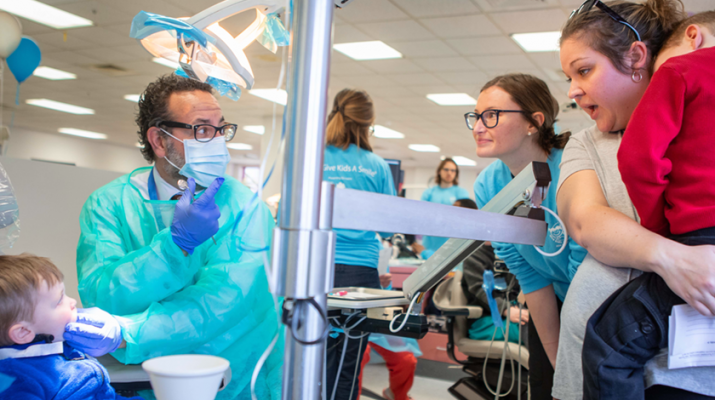Clinics at UB Dental School treat thousands of people every year — it helps patients, gives dental school students experience
By Jana Eisenberg
As part of its teaching and curriculum, the University at Buffalo’s School of Dental Medicine provides low-cost, high-quality dental care to the general public — that’s thousands of children and adults every year.
This real-world experience, performed by dental school faculty, staff and students in the dental school’s well-appointed dental clinics on the south campus, as well as in state-of-the-art mobile dental units, help the school to better prepare its dental students for their professional practice. It’s a win-win-win for the community, the school and its students.
Many of the clinic’s patients may not have access to quality dental care for a variety of reasons. At the clinic and through its programs, people can access this care easily and affordably — regardless of whether they have insurance or money to pay for their visits and treatments.
For the dental students, the experience — that of working with real people, many from underserved populations — can open their eyes to some of the challenges facing those populations. In some cases, students even change their minds about their professional goals, inspired to do good.
And patients receive affordable, respectfully delivered, professional care.
The appointments may take a little longer than the standard private service some might be used to — this is because of the layers of faculty oversight and instruction.
Rather than feel put out by that, many patients say that they are happy to be part of contributing to future dentists’ training — without patients, the dental students could not complete their studies.
“Something we hear all the time is patients saying how much they love the UB Dental Clinic,” said Julie Rockmaker, a social worker on the staff. “Patients have trust in us, and they take pride in the fact that we’re a teaching and research institution.”
The services go beyond standard dental care, added Rockmaker. As a social worker, she’s there to help patients overcome any challenges to accessing regular dental care, and also identify other areas where patients might need assistance.
“We want to help relieve barriers to dental care for people in the community,” she said. “It might be making sure they have transportation to get to their appointments, or helping them deal with other health issues. If they need help applying for insurance, we can do that. Maybe they are the caretaker for a parent or children, and they need respite coverage so they can come to their appointment. We help get the kids on Medicaid or Child Health Plus. We also have grant funds available for patients to cover the cost of treatment.”
With this attitude, the school tries to impart a holistic approach to dentistry — that oral health is not just about the teeth and mouth, but being aware of the person and their needs.
“Dental students learn to listen to their patients. From conversations when the patient is in the chair, they can identify an issue, either from what they’re told or what they observe,” said Rockmaker. “They will give me the patient’s number, or have me come talk to the patient while they’re here. Whatever issues they patients have, it’s easy to connect them with a service provider in the community.”
In addition to public outreach and screening events, UB Dental Clinic connects with school children through its school-based health center (SBHC) and the Gateway program.
For children, the SBHC process includes sending out thousands of parental consent forms every year through Buffalo Public School nurses. Once parents fill out the forms, indicating that they do want their child to receive care, visits are coordinated, with transportation provided to and from schools. This removes barriers for parents who may not be able to take their kids to regular appointments.
“We see some kids who have never been to the dentist,” said Julie Caizza, a dental hygienist and UB Gateway coordinator. “Once we have the kids scheduled, we aim for a 90-minute turnaround from the time they are pulled out of school: they get on a bus [paid for by UB], they’re accompanied by a chaperone from their school, and the parents don’t have to worry about things like missing work.”
The dental student population is diverse, and so is the greater Buffalo population. “Sometimes in the clinic, you can hear them paging for anyone fluent in Arabic, for example,” said Caizza. “Because we have so many international students, we can easily overcome any language barriers—and if we don’t have someone on-site who can interpret, we can call a language line, which has interpreters and translators in many languages.”
Another way that the dental school connects with community is with its mobile dental van, which has been dubbed “S-miles To Go.” A 42-foot long, three-chair, fully equipped dental clinic within a truck, the van heads out annually to over 30 schools in Western New York’s Southern Tier. The van also makes trips to community centers, where the dentists on board can treat seniors and veterans who may not be able to make it to a dentist’s office. It’s so busy that the school is looking into getting a second van.
In order to better serve both its students and the people of Western New York, the clinic will soon be getting a $30 million renovation. That’s something to smile about.

